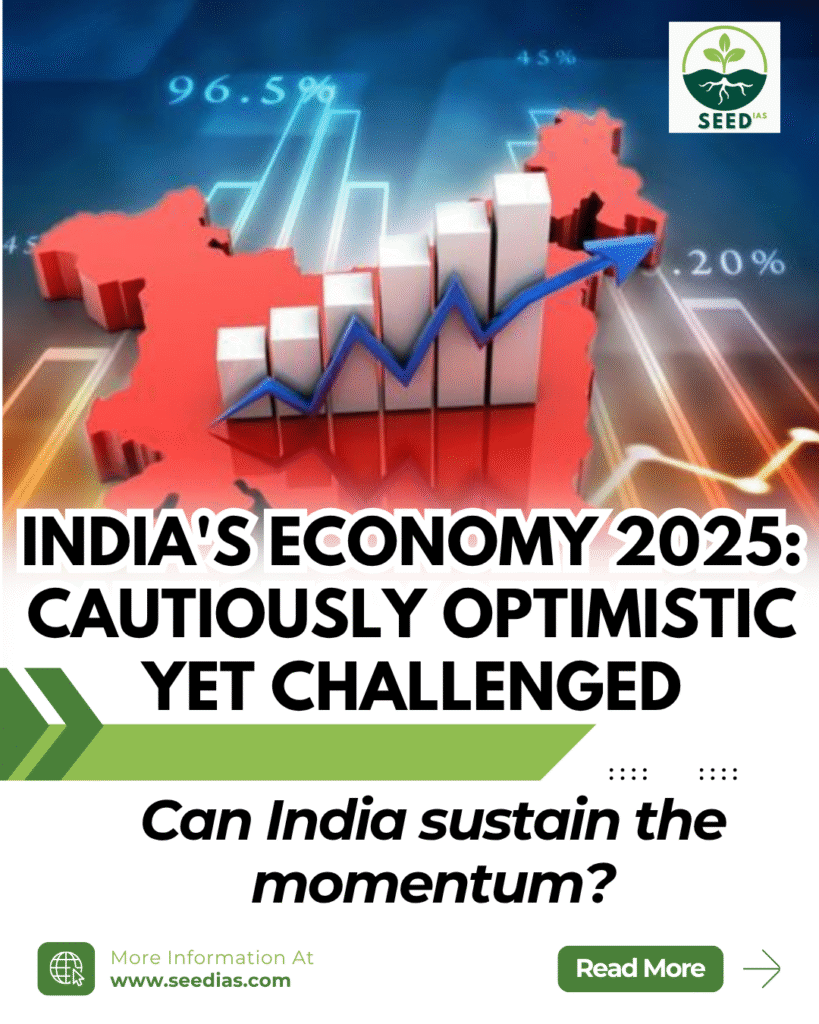Why in NEWS
The RBI’s State of the Economy article provides a cautiously optimistic outlook for India, amid global headwinds and fiscal-tightrope walking.
Key Concepts and Terms
| Term | Explanation |
|---|---|
| Retail Inflation (CPI) | Measures the average change in prices of goods and services consumed by households. |
| Core Inflation | CPI minus volatile items like food and fuel; shows long-term inflation trends. |
| Current Account | A measure of a country’s trade (exports-imports of goods/services), income, and transfers. |
| Fiscal Deficit | The gap between government spending and its revenue (excluding borrowings). |
| FDI & FPI | FDI: Investment in physical assets. FPI: Investment in financial markets. |
| Foreign Exchange Reserves | Assets held by RBI in foreign currencies to back liabilities and support the rupee. |
| Index of Industrial Production (IIP) | Measures industrial sector performance—mining, manufacturing, electricity. |
Current Economic Indicators and Performance
| Area | Data / Insight |
|---|---|
| Inflation | Retail inflation fell to 2.1% in June 2025 (lowest since Jan 2019). Core inflation rose to 4.4%. Rural inflation: 1.7%, Urban: 2.6%. |
| BoP | Current Account Surplus of 1.3% in Q4 2024–25; FY24 CAD narrowed to 0.7%. |
| Fiscal Health | GFD at 0.8% of FY26 BE (improved from 3.1%). 21% receipts & 14.7% expenditure till May 2025. |
| Trade | Trade deficit narrowed by 30% in May 2025. Exports ↑ by 2.8%, Imports ↓ by 1%. |
| Export Boosters | Coffee, tobacco, electronics, rice, drugs, RMG, engineering goods, fruits & vegetables. |
| FDI Inflows | Rose 14% in FY25. Maharashtra top state (39%), Singapore top source (30%). Manufacturing FDI ↑ by 18%. |
| FPI | Net positive inflows of USD 44.1 billion in FY24. |
| External Debt | ↑ by 10%, debt-to-GDP rose to 19.1%. |
| Forex Reserves | At USD 696 billion (11 months import cover, 95% of external debt). |
Present Challenges Impacting Growth
| Category | Issue | Impact |
|---|---|---|
| Global | Iran-Israel tensions, rising tariffs (like 1930s level) | Raises import costs, affects inflation |
| Global weak sentiment | Reduces export demand | |
| Sticky global inflation | Tighter monetary policy = less FPI & costlier borrowing | |
| Domestic | IIP growth at 1.2% (May 2025) | Weakens manufacturing and job creation |
| Credit to NBFCs & Industry ↓ | Investment slump, loan sanctions fell sharply | |
| GST growth only 6% (June 2025) | Indicates demand slowdown | |
| Rural job stress | Lean agri season + heatwaves → lower participation | |
| State subsidies ↑ | Diverts funds from capex, infrastructure |
In a Nutshell
Mnemonic: ICE-TAG
I – Inflation low but Core inflation sticky
C – Credit growth sluggish
E – Exports rise, FDI strong
T – Trade deficit narrowing
A – Agricultural distress rising
G – Global headwinds tighten
Prelims Questions
- Which of the following factors contributed most to India’s current account surplus in Q4 2024–25?
a) Increase in gold imports
b) Decline in oil prices and rise in service exports
c) FDI in agriculture
d) High rural consumption - Which of these countries was the top source of FDI into India in FY25?
a) US
b) Mauritius
c) Singapore
d) UAE - What was the key reason for the drop in India’s trade deficit in May 2025?
a) Fall in services exports
b) Weakening rupee
c) Rise in personal care imports
d) Fall in oil prices and rise in services exports
Mains Questions
- India’s macroeconomic outlook in 2025 showcases strong external metrics but persistent internal weaknesses. Discuss. 10 Marks
- In light of global uncertainties and sluggish domestic indicators, what reforms can India pursue to ensure sustainable growth? (GS3: Indian Economy) 10 Marks
Prelims Answer Key
| Q | Answer | Explanation |
|---|---|---|
| 1 | b | Falling oil prices and stronger service exports led to a BoP surplus. |
| 2 | c | Singapore contributed 30% of FDI inflows in FY25. |
| 3 | d | Both decline in oil prices and rise in service exports helped narrow the trade gap. |
















